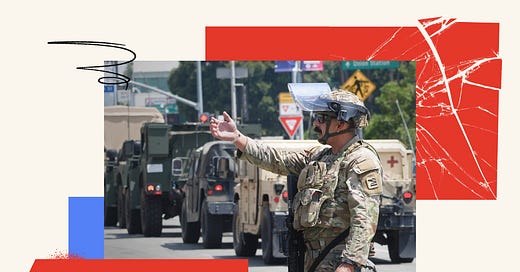Sowing confusion in LA with the military
How to respond to an unnecessary crisis
Late Saturday, against the wishes of California’s governor, the president federalized the National Guard and deployed them to Los Angeles to respond to protests against a wave of immigration raids in the city.
Yesterday afternoon, the Secretary of Defense ordered a 700-person Marine Corps battalion to join the federalized National Guard troops in Los Angeles.
This is all extremely unusual. And it is extremely troubling.
The last time a president deployed the National Guard against the will of a governor was sixty years ago — in 1965 to protect Civil Rights marchers in Alabama. That alone makes this a major escalation.
With tanks ready to roll through DC on his birthday, the president’s decision to disregard the views of state and local authorities and put military boots on the ground is but the latest step in the administration’s efforts to remake the role of the U.S. Armed Forces — an escalation that poses enormous risks to both civilian and military communities.
The president’s order is unneeded and prompts more questions than answers
Leading up to Saturday’s order, the protests in Los Angeles were relatively small and geographically limited. Mostly they were concentrated in a small area around a detention facility. There was little indication that local law enforcement was overwhelmed or unable to deal with the situation. In fact, there was not much of a situation to “deal with” at all until President Trump issued his order calling in the National Guard.
The White House and Pentagon usurped state authority and bypassed all normal procedures for states and localities to request federal assistance.
Shortly after 5 PM local time on Saturday, the governor publicly stated that California did not require military assistance and that he believed deploying the military would only escalate the situation. Less than two hours later, the president unilaterally federalized National Guard troops anyway, despite the Los Angeles Police Department maintaining that the situation was under control.
The president’s memo issuing the order doesn’t specify a city or state for their deployment, nor does it specify that the role of the Guard is only to respond to violence. Instead, it authorizes the activation of the National Guard and the regular Armed Forces wherever “protests … are occurring or are likely to occur.”
In other words, the current deployments in Los Angeles probably won’t be limited to Los Angeles, or even to California. This carte blanche to deploy the military in the U.S. is unprecedented. Under this order, any inkling of a protest could now be cited as justification for troops on your street.
The federal troops’ role is supposed to be limited to protecting federal personnel and property under the cited statute, but its invocation under these circumstances has little legal precedent to understand what that means in practice –– consider that the 101 freeway in Los Angeles, a hub of activity over the last few days, is one of a number of federal roadways crisscrossing the city. It also doesn’t cap how many National Guard or active-duty troops can be deployed, and the latter isn’t limited to 60-day deployments like the Guard.
Why the Armed Forces shouldn’t police our streets
The National Guard is trained to support national defense and respond to emergencies like natural disasters — not to act as a domestic police force. The Marines are even less prepared to respond to domestic civil unrest.
Unlike local, state, and federal law enforcement, they are not trained in the legal complexities, community dynamics, and de-escalation tactics that policing demands. As Alex Tausanovich wrote last year:
“Even if the military had unlimited resources (it doesn’t), it is not in the business of preparing soldiers to do a hodgepodge of domestic jobs. Deploying soldiers to function in tense situations without adequate training or clear objectives is not only a disservice to the members of our armed forces, it can be genuinely dangerous.”
History bears this out. Consider what happened in 1992, the last time federal troops were deployed in LA (that time, at the governor’s request). One incident involved police officers that responded to a domestic violence call with Marines as backup. As recounted by Joseph Nunn, after a shotgun was fired at them through the door, “one of the officers shouted to the Marines, ‘Cover me’—a request, in law enforcement parlance, that they raise their weapons and be ready to fire if necessary. But the Marines, in accordance with their own training, took it as a request for suppressing fire. They riddled the home with more than 200 bullets. Miraculously, no one was killed.”
And now, unlike in 1992, Guardsmen and Marines have been deployed without the consent of local or state authorities — or any consultation at all. Local law enforcement, in almost all situations, should be the principal responders and coordinators, with National Guard troops acting as back up. The president’s decision to override local authorities risks creating deadly confusion due to competing command structures and limited coordination.
It’s not fair to our service members or the American people to put them in this untenable position to score political points.
What’s more, deploying service members into partisan, highly charged domestic situations risks politicizing the military. The National Guard is made up of citizen-soldiers: Americans who serve both their states and the country. Their legitimacy hinges on being seen as apolitical public servants who are trusted to protect, not provoke. When troops are sent into communities that didn’t request them — especially to enforce controversial policies or suppress protests — it erodes that neutrality and damages public trust. And in the fog of the moment, it can be difficult for protesters and the general public to discern who is police, other law enforcement, National Guard, or Marines. This confusion about roles and authority can escalate tensions and create dangerous confrontations with potentially deadly consequences.
Our troops should never be used to send a political message or create a spectacle, whether on American streets or in a military parade (like the one planned this weekend in DC on the president’s birthday).
Why oversight matters, especially now
The President isn’t the only one with a seat at this table: Congress has a responsibility to assure the Guard and active-duty forces alike are mission ready. With fire season rapidly approaching, hurricane season underway, and a long hot summer ahead, dispatching the Guard to American streets reduces their readiness to respond to Mother Nature’s worst. In fact, the lawsuit California filed against the Trump administration on Monday notes that among the federalized National Guard units are a large number of Guardsmen who serve in the state’s specialized fire combat unit — Guardsmen now unavailable to combat wildfires for the duration of this deployment. The deployment also impairs the ability of Guard units and active-duty troops alike to meet the genuine national security challenges our country faces.
Beyond safety concerns, these deployments carry a steep financial cost. Local law enforcement costs a fraction of what it takes to deploy the Guard or active-duty troops given housing, equipment, transport, and hazard pay.
And when they aren’t housed, they end up sleeping on the floor.
The federal National Guard mission in Los Angeles will cost $134 million, according to the interim defense department comptroller — over $2.2 million per day, based on the 60-day authorization. When federalized, the expense comes out of the federal defense budget, diverting funds from other defense and emergency needs. If training budgets are cut to support these deployments, policymakers need to be asking whether these decisions from the White House are undermining military readiness.
There are also military family issues at stake, which policymakers must address. These deployments take a toll on military families, who often face prolonged separations, increased childcare burdens, and disruptions to employment and education. Already, the Pentagon has announced a diversion of $1 billion from military housing — which is already underfunded and insufficient for countless military families — to cover immigration-related missions. If the president pushes the military into domestic politics, it harms our civilian and military communities alike.
How to respond to this unnecessary crisis
Looking ahead, we offer three suggestions for how to respond:
Keep the emphasis on nonviolent, non-confrontational protest. The TV images of military personnel facing violent chaos are simply not the reality in most of Los Angeles. Protesters across the country should keep it that way and not hand the administration the pretext to escalate further. Those who wish to stand in solidarity by protesting should consider treating it as a patriotic exercise of their First Amendment rights, American flags and all. (If you’re looking for a good opportunity, this Saturday’s “No Kings” protests will be happening in a city near you.)
Contact your representatives to call for increased oversight. Another way to make your voice heard would be to contact your state and federal representatives to let them know how you feel about the presence of the Armed Forces on American streets. Find your representatives and their contact info here.
Do not accept politicization of the National Guard and military as normal. Again, the White House wants to normalize the president using troops to carry out his political agenda. Sustained criticism — above all on behalf of the servicemembers that the president seeks to use for political ends — is critical to ensure this politicization is rejected and not repeated.
For more on domestic deployment of the military, see here.











Keep the light shining and exposing the problems to sunlight, the ultimate disenfectant... great work